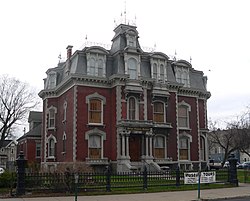
Binghamton is a city in, and the county seat of, Broome County, New York, United States. Surrounded by rolling hills, it lies in the state's Southern Tier region near the Pennsylvania border, in a bowl-shaped valley at the confluence of the Susquehanna and Chenango Rivers. Binghamton is the principal city and cultural center of the Binghamton metropolitan area, home to a quarter million people. The city's population, according to the 2020 census, is 47,969.

The Bartow–Pell Mansion is a historic house museum located in the northern portion of Pelham Bay Park in the Bronx, New York City. A National Historic Landmark, it has one of the nation's finest Greek Revival interiors, and is the last surviving major mid-19th century country estate house in the Pelham Bay area.

The Morgan Library & Museum, formerly the Pierpont Morgan Library, is a museum and research library in the Murray Hill neighborhood of Manhattan in New York City. It is situated at 225 Madison Avenue, between 36th Street to the south and 37th Street to the north.
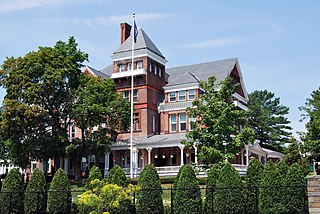
The New York State Executive Mansion is the official residence of the governor of New York. Located at 138 Eagle Street in Albany, New York, it has housed governors and their families since 1875.
Westernville, New York is a hamlet in Oneida County, located west of Adirondack Park and north of Rome, and Utica. Westernville is in the Town of Western, adjacent to Delta Reservoir and Delta Lake State Park.
The Wyoming Governor's Mansion is the official residence of the governor of Wyoming. The current mansion was built during 1976 in Cheyenne.

Glencairn is a castle-like mansion in Bryn Athyn, Pennsylvania, that was home to the Pitcairn family for more than 40 years. Now the Glencairn Museum, it contains a collection of about 8,000 artworks, mostly religious in nature, from cultures such as ancient Egypt, ancient Greece, the Roman Empire and medieval Europe, as well as Islamic, Asian, and Native American works. The museum is affiliated with The New Church, and the building is on the National Register of Historic Places.

Isaac Gale Perry (1822–1904), was a prolific New York State architect and builder. His works include New York State Inebriate Asylum, Monday Afternoon Club, Phelps Mansion and the First National Bank of Oxford.

The Mount Vernon Hotel Museum & Garden, formerly the Abigail Adams Smith Museum, is a historic antebellum residential building at 421 East 61st Street, near the East River, in New York City. It is open to the public as a museum.
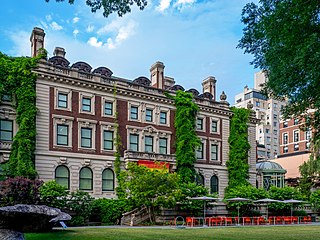
The Andrew Carnegie Mansion is a historic house located at 2 East 91st Street at Fifth Avenue in the Upper East Side of Manhattan, New York City, New York. Andrew Carnegie moved into his newly completed mansion in late 1902 and lived there until his death in 1919; his wife, Louise, continued to live there until her death in 1946. The building is now the Cooper-Hewitt, Smithsonian Design Museum, part of the Smithsonian Institution. The surrounding area, part of the larger Upper East Side neighborhood, has come to be called Carnegie Hill. The mansion was named a National Historic Landmark in 1966.
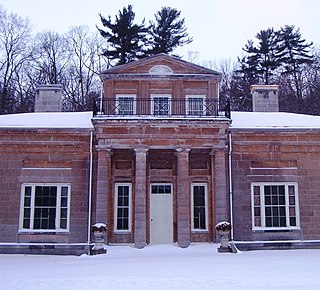
Hyde Hall is a neoclassical country mansion designed by architect Philip Hooker for George Clarke (1768–1835), a wealthy landowner. The house was constructed between 1817 and 1834, and designed with English and American architectural features. It was designated a National Historic Landmark in 1986 for its architecture, and the completeness of its architectural documentary record. It is one of the few surviving works of Philip Hooker, a leading 19th-century American architect.

The Roberson Mansion, part of the Roberson Museum and Science Center, is a home in Binghamton, New York. It is an Italian Renaissance style house, designed by Binghamton architect C. Edward Vosbury and built in 1904, and completed in 1907, for Alonzo Roberson Jr. and his wife Margaret Hays Roberson. It was built with all of the then modern conveniences: an elevator, central heat, combination gas and electric lighting, a dumb waiter, an intercom system, and a private bath for each bedroom.
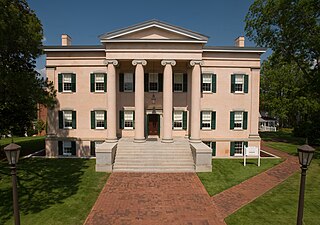
Georgia's Old Governor's Mansion is a historic house museum located on the campus of Georgia College & State University (GCSU) at 120 South Clarke Street in Milledgeville, Georgia. Built in 1839, it is one of the finest examples of Greek Revival architecture in the American South, and was designated a National Historic Landmark for its architecture in 1973. It served as Georgia's executive mansion from 1839- 1868, and has from 1889 been a university property, serving for a time as its official president's residence. It is an accredited museum of the American Alliance of Museums and in 2015 was named an affiliate of the Smithsonian Institution.

The Hart-Cluett Mansion is located at 57 Second Street in Troy, New York, United States. It was listed on the National Register of Historic Places in 1973, and is a contributing property to the Central Troy Historic District created in 1986. Since the 1950s it, and the Carr Building next door, has been the main office of the Rensselaer County Historical Society, The house is open to the public as a historic house museum.

Bohemian National Hall is a five-story building at 321 East 73d Street on the Upper East Side, Manhattan. The building was built between 1895 and 1897 in neo-Renaissance style by architect William C. Frohne. It was a Czech American social and culture center in New York City. From the late 1930s to the 1980s it was rented out to various organizations, including the Manhattan Theater Club, which began there. In 1994 the New York City Landmarks Preservation Commission named it a landmark.

The Sulgrave Club is a private women's club located at 1801 Massachusetts Avenue NW on the east side of Dupont Circle in Washington, D.C. The clubhouse is the former Beaux-Arts mansion on Embassy Row built for Herbert and Martha Blow Wadsworth and designed by noted architect George Cary. During World War I the Wadsworth House was used as the local headquarters for the American Red Cross.

Broome County Courthouse is a historic courthouse located at Binghamton in Broome County, New York. It is a massive 2+1⁄2-story structure, built on a raised foundation, in the form of a Latin Cross and topped with an elegant copper dome. Originally constructed in 1897–1898 in a "T" shape, the south wing was added in 1916-1917 to form the cross. It was designed by noted New York State architect Isaac G. Perry. The courthouse is located within the boundaries of the Court Street Historic District.
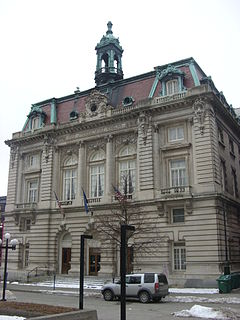
Binghamton City Hall is a historic city hall located at Binghamton in Broome County, New York.
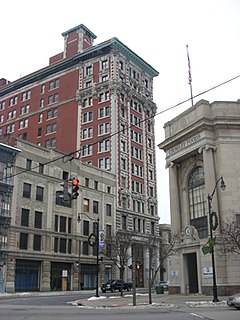
Court Street Historic District is a national historic district located at Binghamton in Broome County, New York. The district includes 87 contributing buildings and encompasses the historic downtown core of downtown Binghamton. The majority of the contributing structures are commercial buildings built between about 1840 and 1939. Ten and twelve story office buildings built in the 20th century are prominent features of the district. Located within the boundaries of the district are the separately listed Broome County Courthouse and Binghamton City Hall.

Railroad Terminal Historic District is a national historic district in Binghamton in Broome County, New York. The district includes 19 contributing buildings. Four of the buildings were directly related to Binghamton's rail passenger and freight operations, including the passenger station. Five buildings were built as warehouses, and ten were built to house retail activities with residential or office uses on the upper floors. The buildings were built between 1876 and 1910, with a major addition to one of them completed in 1932. This Delaware, Lackawanna and Western Railroad passenger station, with its Italian Renaissance campanile, was built in 1901. For most years of passenger service to Binghamton, Delaware and Hudson Railway and Erie Railroad trains used a different station 150 yards away.
